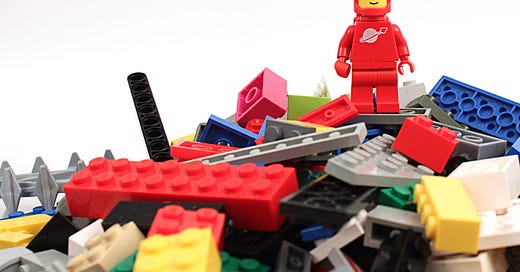LEGO's Comeback Story: Insights & Lessons
The Rebirth of LEGO: Innovation and Diversification for Success
Founded in 1932, LEGO became a beloved toy brand known worldwide for its iconic interlocking brick systems. However, by the early 2000s, LEGO faced a severe financial crisis, teetering on the edge of bankruptcy.
It was only through a drastic reimagining of its business strategy that LEGO managed to stage one of the most impressive turnarounds in corporate history, transforming itself from a struggling toy company into a global entertainment powerhouse.
Here are insights into how LEGO was able to do it, and also what we can learn from it.
The Growth Game newsletter brings you quick insights & learnings form the business case studies. Subscribe now.
Key Insights into LEGO's Success
Refocusing on Core Products: By the late 1990s, LEGO had overextended itself by entering into numerous segments including clothing, theme parks, and complex technic sets. The brand was in disarray and had lost its unique selling proposition. The turnaround began in earnest when Jørgen Vig Knudstorp, a former McKinsey consultant, took the helm as CEO in 2004. He implemented a strategy that refocused the company on its core product – the LEGO brick. This return to basics helped LEGO streamline its manufacturing processes, cut costs, and renew its brand identity.
Expanding into New Media: Alongside this return to the basics, LEGO recognized the importance of evolving with changing times. It successfully entered the digital arena by investing in video games and online content. Through smart partnerships with established franchises such as Star Wars, Batman, and Harry Potter, LEGO released popular video games that not only generated revenue but also bolstered the brand among a new digitally-savvy generation.
Exploring Brand Extensions: LEGO’s diversification strategy this time was more in line with its brand and competencies. In 2014, it ventured into movies with "The LEGO Movie," a surprise hit that spawned sequels and numerous spin-offs, not to mention driving impressive toy sales. The movie and its offshoots presented LEGO as more than just a toy company, framing it as a multimedia brand.
Engaging the Community: LEGO adopted a unique strategy of involving its loyal customer base in its product development process. It launched the LEGO Ideas platform, a community-based hub where fans could submit their own ideas for new LEGO sets. If an idea received enough public support, it would be reviewed by LEGO and potentially put into production, with the creator receiving a small percentage of the sales. This crowdsourcing strategy fueled innovation and deepened engagement with LEGO’s enthusiastic community.
Key Learnings from the LEGO Case Study
Returning to Core Strengths: LEGO's return to its iconic brick systems underlined the importance of recognizing a brand's inherent strengths and unique selling points. This recognition can guide a company through turbulent times.
Adapting to Technological Advances: By expanding into digital mediums, LEGO demonstrated the necessity for brands to evolve with technology and market trends. It showed that digital transformation can bolster traditional businesses.
Smart Brand Extension: LEGO’s strategic venture into movies and digital content highlighted how the brand extension can generate additional revenue streams, provided it aligns with the company’s brand identity and competencies.
Community Engagement: LEGO's strategy of involving its user community in product development illustrates the power of crowdsourcing and community engagement. It not only fosters brand loyalty but can also fuel innovation.
LEGO’s turnaround story is not only a lesson in crisis management and strategic business transformation but also an inspiration that even in the face of seemingly insurmountable challenges, a company can rebuild itself to unprecedented heights.
Share & Subscribe:





